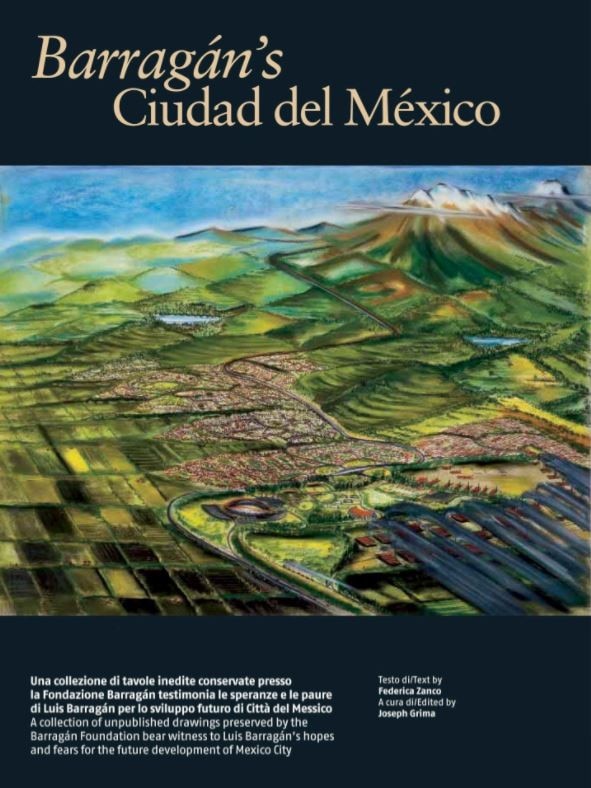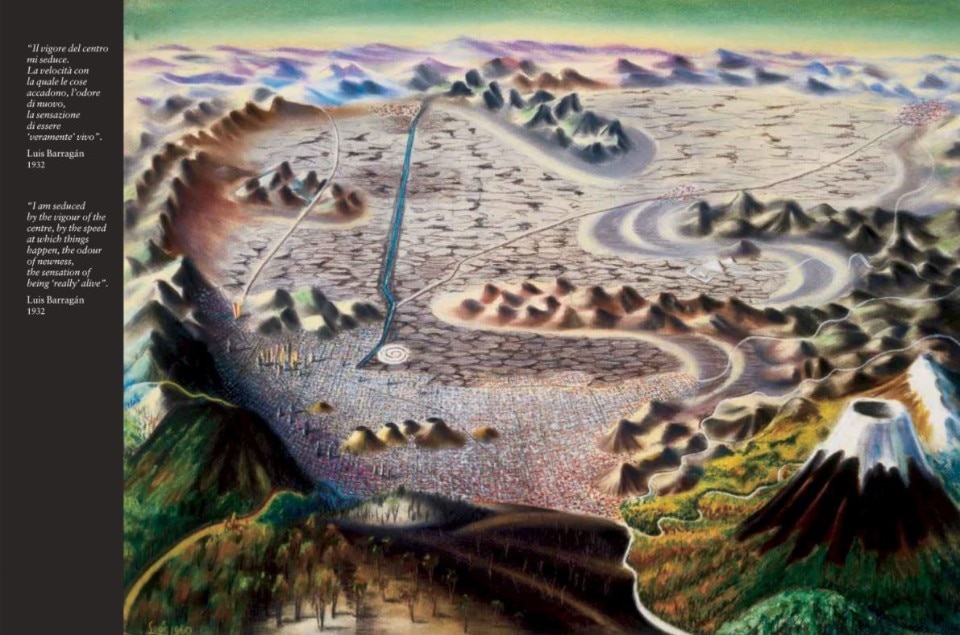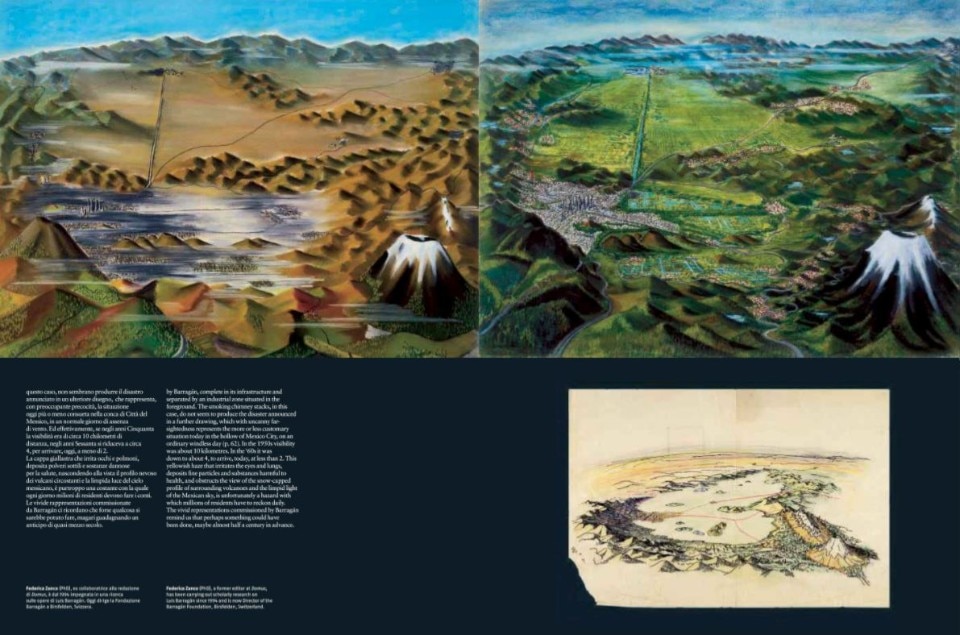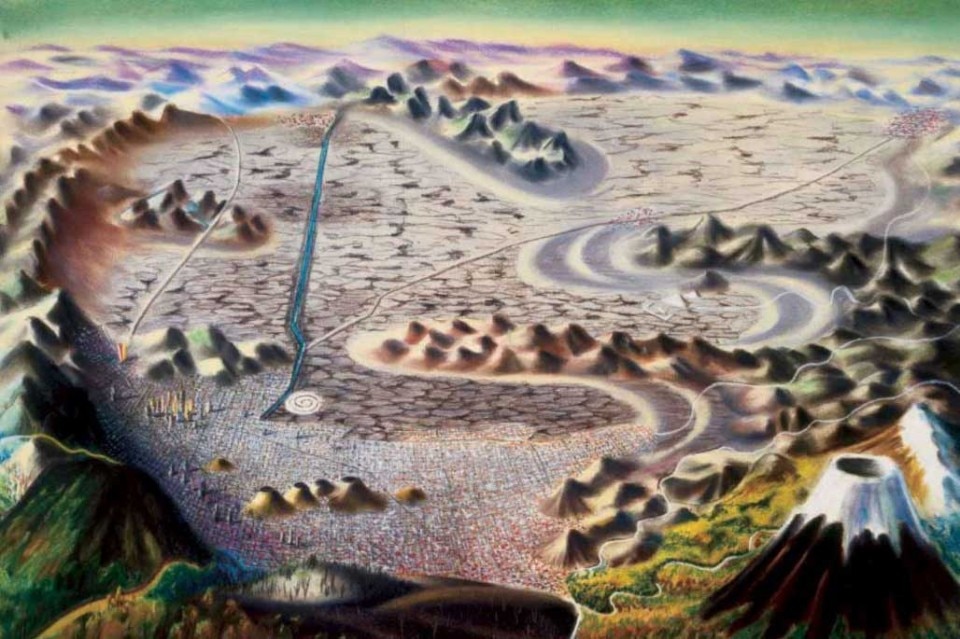This article originally appeared on Domus 899, January 2007.
For those arriving today, from the air, in the great basin of the Valle de México, the city resembles an immense, arid expanse of small low-rise houses that seems to go on forever as the plane comes in to land at Benito Juárez airport. The airport appears by now incongruously set in a decidedly central position within an urban tide that keeps on growing, depositing its spray of concrete far up the slopes of the belt of mountains and volcanoes that encloses the wide valley.
When at the end of 1925 a young Luis Barragán decided to leave the provincial Guadalajara to settle in the capital, the city had just under a million inhabitants. That number rose to a million and a half towards 1940 (doubled in 1950, was up to five and a half million in 1960, to about 9 in 1970, to 14 in 1980, to 15.6 in 1995…). The growing demographic pressure of the early decades of the century soon set off a building boom that brought Barragán his first commissions and earnings, in a crescendo of professional engagements which in 1932 prompted him to remark: “I am seduced by the vigor of the center, by the speed at which things happen, the odor of newness, the sensation of being ‘really’ alive” (text signed by Luis Barragán, dated 12 September 1932, published in: Antonio Riggen, Luis Barragán: Escritos y conversaciones, Madrid 2000).

The magnificent series of unpublished plates kept in the Barragán archives, and partially presented for the first time in the monographic exhibition organized since the acquisition and cataloguing of the archives by the Barragán Foundation (“Luis Barragán: The Quiet Revolution”, Vitra Design Museum, June-October 2000), has not so far been precisely linked to any known project, nor to any account by friends or collaborators. In a conversation of mine in 1995 – alas early in terms of the progress of work in this field of research – with Señor Alejandro Margain Flores, who worked for 20 years in Barragán’s office from May 1949, he vaguely mentioned some drawings which the architect had commissioned to be done as his visions of the development of Mexico City.
This was not unusual for Barragán, whose archives witness the largesse with which he commissioned numerous copies of large, quality photographic prints, collages, presentation plates and renderings. These were not always necessarily related to projects prepared by him, but at times devoted to particular natural or architectural details evidently of interest to him personally or considered worthy of deeper consideration. It therefore seems probable that, due to the similarity of the theme represented in the diverse variants, the fine colour plates dated 1960 and signed by a certain “Léon”, are part of a reflection whose essential lines are illustrated in his article published in El Zócalo on 12 October 1959 entitled “How great modern cities should develop. The expansion of Mexico City”.
It was a critical reaction to the proponents of the vertical city, which Barragán opposes in favor of horizontal expansion, adopted as of his study depicting Mexico City’s geographic situation. This involved various versions of a couple of bird’s eye views of the Valley of Mexico, where the volcanoes that encircle its southern rim are conspicuous in the foreground.

The first drawing in Indian ink and pastel on semi-transparent paper (facing page, bottom) probably shows the nucleus of the colonial city copied onto the structure of the ancient Aztec capital, and the two main thoroughfares respectively towards Cholula-Puebla and towards the monumental Teotihuacán complex. A variant shows the ancient lake zone, which was later drained and reclaimed by the Spanish. After various attempts this was eventually achieved around the beginning of the 18th century, and the city was freed once and for all from its recurrent flooding with the completion of a system of underground canals.
I am seduced by the vigor of the center, by the speed at which things happen, the odor of newness, the sensation of being ‘really’ alive.
The lively chalk on cardboard drawings are not dissimilar to a figurative/cartographic tradition that includes great names like Juan Gómez de Trasmonte, José Maria Velasco and Gerardo Murillo – known as Dr Atl – up to the contemporary Juan O’Gorman and Jorge Covarrubias. In these works the various representations seem to refer to the historic city’s different possibilities for expansion and development. In fact one sees the straight line of the gran canal, and the spiral of the catacol, or the city’s principal water supply and treatment system. While one version shows a thriving image of the whole valley, probably based on a far-flung network of canals and irrigation, as well as a planned expansion of the urbanized zone through a garden city belt modelled on the “Jardines del Pedregal” type, the other shows an arid valley, where an expansion and density evidently out of control encroaches on every available space, wasting precious water and environmental resources

A further detailed drawing, apparently referring to the new expansion zone and possibly identified with the south part of the city – as suggested by the drawing of a stadium very similar to the Olympic Stadium built near the University Campus in 1952 – might represent one of the satellite cities cherished by Barragán, complete in its infrastructure and separated by an industrial zone situated in the foreground. The smoking chimney stacks, in this case, do not seem to produce the disaster announced in a further drawing, which with uncanny farsightedness represents the more or less customary situation today in the hollow of Mexico City, on an ordinary windless day. In the 1950s visibility was about 10 kilometers. In the ‘60s it was down to about 4, to arrive, today, at less than 2.
This yellowish haze that irritates the eyes and lungs, deposits fine particles and substances harmful to health, and obstructs the view of the snow-capped profile of surrounding volcanoes and the limpid light of the Mexican sky, is unfortunately a hazard with which millions of residents have to reckon daily. The vivid representations commissioned by Barragán remind us that perhaps something could have been done, maybe almost half a century in advance.
Opening image: Domus 899, January 2007


